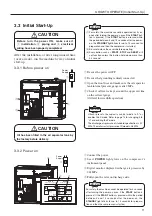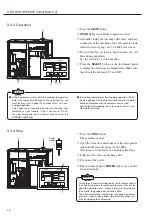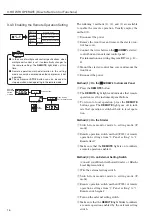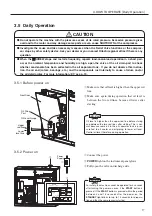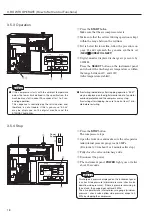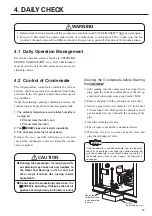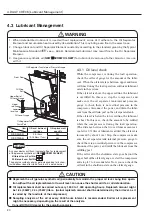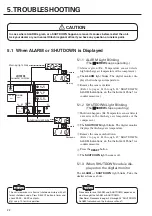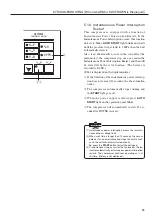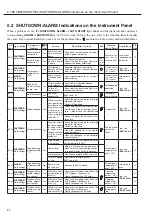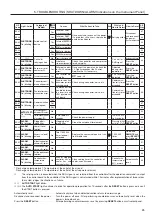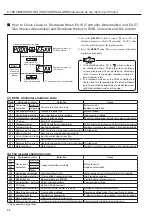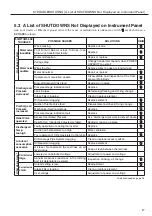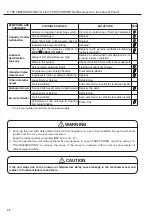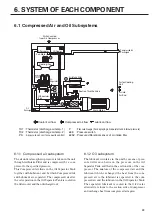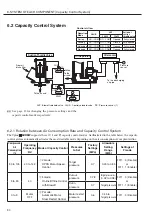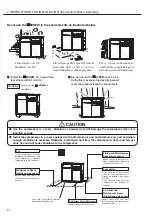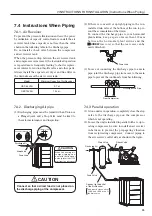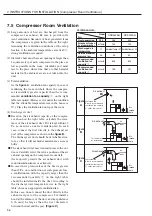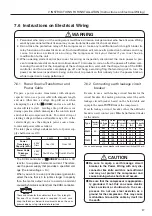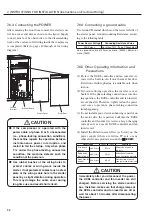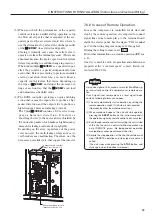
5.2 SHUTDOWN/ALARM Indications on the Instrument Panel
When a problem occurs, the
SHUTDOWN, ALARM
or
AUTO START
light blinks and the digital monitor displays a
corresponding
ALARM
or
SHUTDOWN
(as ‘A/S’ below) code. If this is the case, refer to the following table to identify
the cause. If you cannot identify the cause, or for the problem with a
mark in the table, contact a Hitachi distributor.
A/S
Code
Light: Action
Category of
Problem
HISCREW
Shutdown
Causes
What Actions to Take
Mark
What and
How to Detect
How to Reset
A/S
History
E0.01
SHUTDOWN
:
On (blinking)
Reversal phase
connection
Yes
Power connect-
ed in a reversal
phase
Disconnect the power and change 2
of the 3 power cord wires.
Detected for 3 sec-
onds after con-
necting the power
Disconnect
and reconnect
the power.
01
Phase-lacking
connection
Yes
Power connect-
ed with a lack of
T phase
Disconnect the power.
Check the power supply. Tightly re-
connect the power cord wires.
For R, S
phase
see
§7.6.3
E0.11
SHUTDOWN
:
On (blinking) Discharge air
temperature 2
(TH2)
Yes
Oil separator
element exit tem-
perature rise
Separator element abnormality.
Separator element, lubricant replace-
ment is required.
Separator element
exit temperature
110
℃
or higher
Press the
RESET
button.
11
E0.24
ALARM
:
On (blinking)
Same cause as
shutdown blink-
ing
Same countermeasures as for shut-
down blinking
Separator element
exit temperature
105
℃
or higher
Automatically
reset.
24
E0.12
SHUTDOWN
:
On (blinking)
Abnormally
high discharge
air pressure
Yes
Failure of oil sep-
arator element
Check the oil separator element.
Replace if required.
Detected during
operation
Press the
RESET
button.
12
Failure of
contactor 52
Disconnect the power and tightly re-
connect the 52 wires.
E0.13
※※※
Controller abnormality Yes
Controller
abnormality
see p. 26
The controller
detects the failure.
E0.17
SHUTDOWN
:
On (blinking)
Motor overload
Yes
Motor overcur-
rent, power sup-
ply abnormality,
high discharge
air pressure, oil
s e p a r a t o r e l e -
ment clogging
(See E0.11)
Check the power supply for a voltage
drop and imbalance.
Correct it if required.
Overcurrent
Press the
RESET
button.
17
Check and correct the capacity con-
trol settings, if the discharge air pres-
sure is higher than the specification
pressure.
Check the motor for insulation resis-
tance etc.
E0.53
SHUTDOWN
:
On (blinking)
Fan motor overload
Yes
Fan motor overcur-
rent, dirty or clogged
oil cooler and af-
ter-cooler, dirty or
clogged controller’
s and fan inverter’s
cooling fi ns
Check the power supply for a voltage
drop and imbalance.
Correct it if required.
The fan inverter
detects the
failure.
Press the
RESET
button.
53
Clean the cooling fins of oil cooler
and after cooler.
Clean the cooling fi ns of the controller
and fan inverter.
E0.18
SHUTDOWN
:
On (blinking)
High discharge
air temperature
1 (*)
Yes
High ambient
temperature
Ventilate the room to reduce the ambi-
ent temperature to 40
℃.
Discharge air
temperature 1
over 110
℃
Press the
RESET
button.
18
Low oil level
Add oil. (Disconnect the power and
make sure that the discharge air pres-
sure gauge reads 0 MPa in advance.)
Dirty or clogged oil cooler Clean the cooling fins.
see p. 48.
Dirty or clogged
oil filter
Replace the oil filter element.
see p. 46.
E0.23
ALARM
:
On (blinking)
High discharge
air temperature
1 (*)
No
Same as the
E0.18 above
Same as the E0.18 above
Discharge air
temperature 1
over 105
℃
Automatically
reset.
23
E0.31
SHUTDOWN
:
On (blinking)
Failed or discon-
nected tempera-
ture sensor 1
Yes
Failure or discon-
nection of therm-
istor TH1
Disconnect the power and check the
TH1. Replace it if necessary.
Tightly reconnect the TH1 wires.
Operating
temperature
below
ー
30
℃
Press the
RESET
button.
31
E0.32
SHUTDOWN
:
On (blinking)
Failed or discon-
nected tempera-
ture sensor 2
Yes
Failure or discon-
nection of therm-
istor TH2
Disconnect the power and check the
TH2. Replace it if necessary.
Tightly reconnect the TH2 wires.
Operating
temperature
below
ー
30
℃
32
E0.34
SHUTDOWN
:
On (blinking)
Failed or discon-
nected pressure
sensor
Yes
Failure or discon-
nection of pres-
sure sensor PSB
Disconnect the power and check the
PS. Replace it if necessary.
Tightly reconnect the PS wires.
0 (zero) MPa
during opera-
tion.
Press the
RESET
button.
34
24
5. TROUBLESHOOTING [SHUTDOWN/ALARM Indications on the Instrument Panel]


